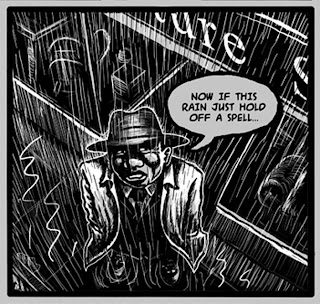Review by Matt C
 BLUESMAN
BLUESMAN
Writer: Rob Vollmar
Art: Pablo G. Callejo
NBM $24.95
There’s the myth of the blues, the romanticised notions that its practitioners made deals with the devil (usually at “the crossroads”) in exchange for their extraordinary musical prowess, consequently becoming something otherworldly - musical magicians that possessed the ability to enrapture audiences with their tales of woe and women who done them wrong. Then there’s the reality: many bluesmen were basically wandering buskers, going from town to town finding work wherever they could to raise a few pennies before moving on. Bluesman acknowledges both the reality and the myth to create a powerful, moving tale set against an evocative backdrop of poverty and intolerance in the Arkansas of the late 1920s.
I’ve long been a fan of blues music, especially those artists who made their names in the pre-WWII years - often consisting of one man alone with his guitar, the early recordings are primal, direct, truthful and in some cases, more potent and affecting than any other music committed to tape, wax or anything else during the last 100 years. The sound quality may be primitive but the emotion conveyed in many of the songs is unmatchable. With this in mind it’s not much of a stretch to see why Bluesman appealed to me instantly. I love the blues, I love comics. Stick ‘em together and, well, it’s kind of a no-brainer really: I’m sold.
The book follows Lem Taylor and Ironwood Malcott, two drifting musicians who arrive in Hope, Arkansas looking for a place to get some food and rest their heads, and maybe an opportunity to play some tunes. What they inevitably find is trouble, and events spiral quickly out of control leading the town’s racist contingent to hunt for someone to string up for murder.

Vollmar gives his characters depth and humanity, moving through the full spectrum of emotions, from ebullience to despair. He creates a world where potential danger is never too far away and brings it to life with dialogue that sparks with authenticity. Callejo’s illustrations initially bring to mind the likes of Robert Crumb and Richard Corben but they quickly establish their own identity, vividly depicting an era of both beauty and violence.
Earlier I described the blues as potent and affecting: I think both these adjectives can be applied to this masterful and memorable example of graphic storytelling. 9/10
 BLUESMAN
BLUESMANWriter: Rob Vollmar
Art: Pablo G. Callejo
NBM $24.95
There’s the myth of the blues, the romanticised notions that its practitioners made deals with the devil (usually at “the crossroads”) in exchange for their extraordinary musical prowess, consequently becoming something otherworldly - musical magicians that possessed the ability to enrapture audiences with their tales of woe and women who done them wrong. Then there’s the reality: many bluesmen were basically wandering buskers, going from town to town finding work wherever they could to raise a few pennies before moving on. Bluesman acknowledges both the reality and the myth to create a powerful, moving tale set against an evocative backdrop of poverty and intolerance in the Arkansas of the late 1920s.
I’ve long been a fan of blues music, especially those artists who made their names in the pre-WWII years - often consisting of one man alone with his guitar, the early recordings are primal, direct, truthful and in some cases, more potent and affecting than any other music committed to tape, wax or anything else during the last 100 years. The sound quality may be primitive but the emotion conveyed in many of the songs is unmatchable. With this in mind it’s not much of a stretch to see why Bluesman appealed to me instantly. I love the blues, I love comics. Stick ‘em together and, well, it’s kind of a no-brainer really: I’m sold.
The book follows Lem Taylor and Ironwood Malcott, two drifting musicians who arrive in Hope, Arkansas looking for a place to get some food and rest their heads, and maybe an opportunity to play some tunes. What they inevitably find is trouble, and events spiral quickly out of control leading the town’s racist contingent to hunt for someone to string up for murder.

Vollmar gives his characters depth and humanity, moving through the full spectrum of emotions, from ebullience to despair. He creates a world where potential danger is never too far away and brings it to life with dialogue that sparks with authenticity. Callejo’s illustrations initially bring to mind the likes of Robert Crumb and Richard Corben but they quickly establish their own identity, vividly depicting an era of both beauty and violence.
Earlier I described the blues as potent and affecting: I think both these adjectives can be applied to this masterful and memorable example of graphic storytelling. 9/10

No comments:
Post a Comment